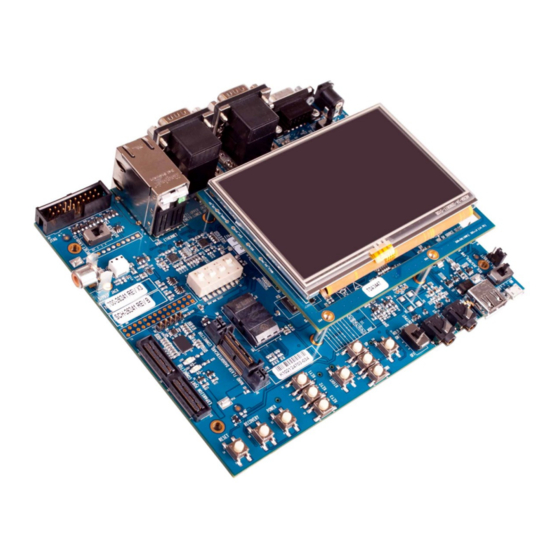
Subscribe to Our Youtube Channel
Summary of Contents for Freescale Semiconductor i.MX28 EVK
- Page 1 Quick Start Guide for i.MX28 EVK i.MX28 EVK Multimedia and connectivity Downloaded from Elcodis.com electronic components distributor...
- Page 2 EVK board: These applications use the i.MX28 series • i.MX28 processor ARM9™ applications processor. The • Double Data Rate2 (DDR2) i.MX28 EVK can be used as a hardware DRAM memory and software development platform. This decreases time to market and provides a • Dual USB connections near-to-final product design.
- Page 3 Line jumper button button keys switch Input USB 5V power Headphone/ switch host Line output jack jack SD card slots on back side Top view of the i.MX28 EVK board without the LCD module. Downloaded from Elcodis.com electronic components distributor...
-
Page 4: Getting Started
Getting Started This section describes how to use the i.MX28 Kit EVK and the components in the EVK. This section also describes the PC requirements to develop applications using the i.MX28 EVK. Unpacking the Kit STEP i.MX28 EVK Development Kit Contents... - Page 5 Quick Start Guide for i.MX28 EVK Web Site Contents Type Requirement • Schematics, layout, and gerber files for EVK and LCD board • i.MX28 EVK Hardware User’s Guide • i.MX28 Windows CE Demo Image Readme • i.MX28 Windows CE Quick Start Guide (this document) • i.MX28 Windows CE Release Notes • i.MX28 Windows CE User’s Guide • i.MX28 Windows CE Reference Manual EVK Documentation • i.MX28 Windows CE Hello World Application Note • i.MX28 Linux Demo Image Readme • i.MX28 Linux Quick Start Guide (this document) • i.MX28 Linux Release Notes • i.MX28 Linux User’s Guide • i.MX28 Linux Reference Manual • i.MX28 Linux Hello World Application Note • Windows CE SDK Installation File Software Development Tools • Linux SDK Installation File Copy of the OS image provided on the SD card— i.MX28 EVK Demo Images Linux demo image and Windows demo image Table 2 Downloaded from Elcodis.com electronic components distributor...
- Page 6 J78 connector is located on the top of the i.MX28 EVK board as shown. NOTE: The 4.3” widescreen video graphics array (WVGA) LCD board is an optional card for the i.MX28 EVK board and it is sold separately from the i.MX28 EVK board. Downloaded from Elcodis.com electronic components distributor...
- Page 7 Quick Start Guide for i.MX28 EVK J78 connector for LCD. i.MX28 EVK board shown without LCD Downloaded from Elcodis.com electronic components distributor...
-
Page 8: Setting Up The Board
Setting Up the Board STEP STEP Connect RS232 Cable Check Jumpers Connect the RS232 cable to the Ensure the jumpers and switches debug UART port (optional). are in their default positions by comparing them to the jumper and switch settings Serial port configuration: 115.2 kbaud, table in this Quick Start Guide. 8 data bits, 1 stop bit, no parity. STEP Insert SD Card STEP Connect Power Supply Insert the appropriate Windows Connect the 5V power supply Embedded CE or Linux SD card into cable to the 5V DC power jack (J84). -
Page 9: For Linux
Quick Start Guide for i.MX28 EVK For WinCE: For Linux: 1. During the boot process, there will be 1. During the boot process, there will be operating system status information operating system status information scrolling on the terminal window of scrolling on the terminal window of the the PC and the Freescale logo will PC and a penguin image in the upper be shown on the 4.3” WVGA display... - Page 10 EVK Board Jumper and Switch Options The following is a list of all the jumper options. The *default* jumper and switch settings are shown in bold with asterisks. Reference Name Setting Description Designator The battery source is a real Li-ion battery connected to either BATT J85 or J86. Battery source select switch *REG* The battery source is the EVK on-board 4.2V regulator.
- Page 11 Quick Start Guide for i.MX28 EVK (continued from previous page) Reference Name Setting Description Designator i.MX28 VDD5V Wall 5V The i.MX28 VDD5V pin is supplied by the 5V DC wall adapter. pin supply selection *USB 5V* The i.MX28 VDD5V pin is supplied by the USB micro AB jack.
- Page 12 For more information, visit freescale.com/iMX28EVK. Join the online i.MX community at imxcommunity.org. Freescale and the Freescale logo are trademarks of Freescale Semiconductor, Inc., Reg. U.S. Pat. & Tm. Off. ARM9 is a trademark of ARM Limited. All other product or service names are the property of their respective owners. © 2010 Freescale Semiconductor, Inc. Doc Number: IMX28EVKQSG / REV 0 Agile Number: 924-76406 / REV A Downloaded from Elcodis.com electronic components distributor...


Need help?
Do you have a question about the i.MX28 EVK and is the answer not in the manual?
Questions and answers